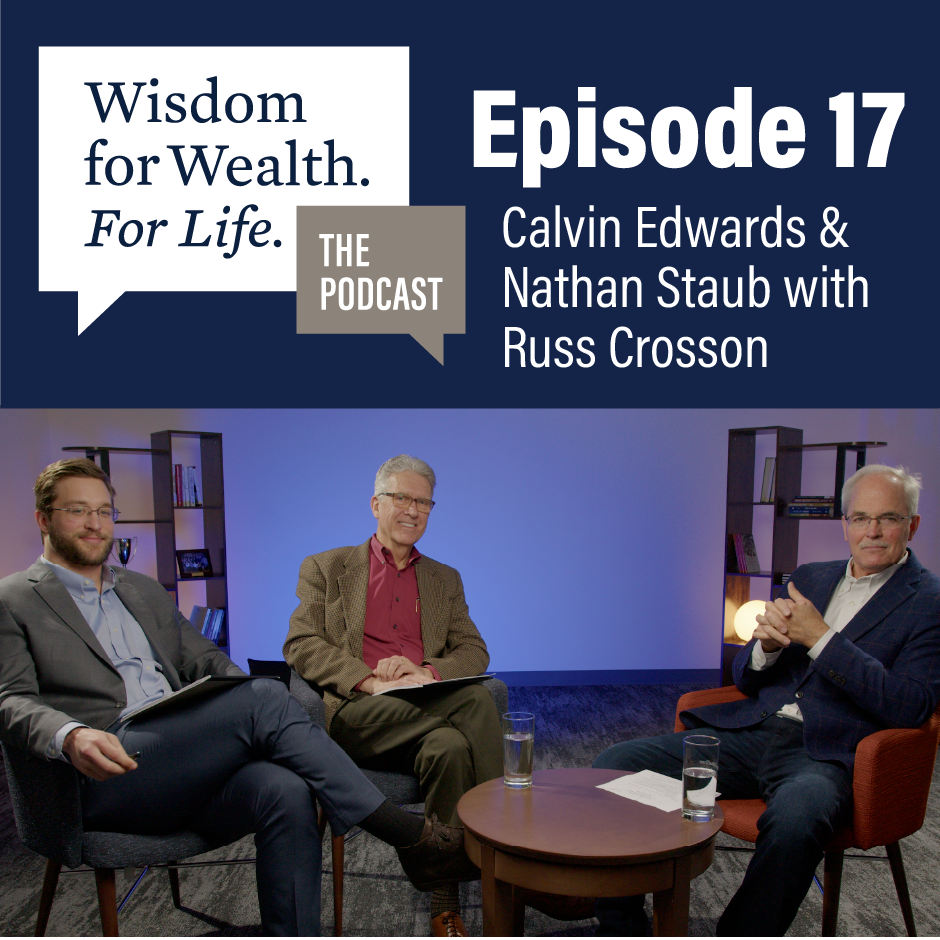“Wisdom for Wealth. For Life.” Episode 17: How to Spot Red Flags in Nonprofits
Putting Generosity into Practice
At Blue Trust, stewardship is a central component of our approach to managing money. We believe that “God owns it all” and we are simply stewards of His blessings and resources. But how do we define stewardship, and more importantly, how do we put it into practice wisely?
In our conversations with clients, we have found that they often would like to use their resources in a generous way, but they aren’t sure how to start or how to make the most impact with their money. Even among high-net-worth families, money meant to be given away can languish in investment accounts, donor-advised accounts, and foundations due to “analysis paralysis” about where to give.
Where to Start with Giving
Your Blue Trust advisor can help you with goal setting and making sure that your charitable giving aligns with the rest of your financial plan. Once you’ve done that, you have a new job: Give! Money earmarked for giving or sitting in a donor-advised fund (DAF) or a foundation is missing out on the compounding good that can happen when ministries are able to carry out their mission. Once you are committed to giving, the next natural questions are the “where, when, and how” to give. We recently had a conversation with Calvin Edwards & Company (CEC), a consulting firm that creates investment-grade research on nonprofit organizations. They also counsel charitable and faith-based entities, foundations, high net worth families, and government agencies. CEC’s purpose was born out of the need to help donors give wisely. Listen to our conversation with CEC below or watch the video at the top of the page.
CEC has found that for many donors what should be a giving joy can turn into a giving burden. There are a seemingly overwhelming number of questions and a general lack of “investment grade” information to make your decision. In addition, donors must address questions like “how do I know the ministry is not healthy and dependent on my giving?” “if a ministry cannot use the money they raised last year, is my donation wasted?” or “How do I get my kids involved with my giving?”
Doing Your Due Diligence
While some people do have the time and interest to research ministries and organizations, others simply would prefer to delegate. The professionals at CEC explain that gathering research from sites like Charity Navigator is a solid and dependable place to start. “Most organizations check out just fine,” explains Calvin Edwards, CEC’s founder. “Charity Navigator does a great job of providing quantitative facts based on the IRS Form 990. ”
However, to understand how an organization is truly performing, it’s important to take other factors into consideration. “Qualitative, nontangible aspects such as intrinsic values, leadership, culture, purpose, and organizational strategy are also important. Numbers alone can’t capture all the good that God may be doing through that organization,” added CEC managing partner, Nathan Staub.
Whether you gather information yourself in a “do it yourself” fashion or engage a philanthropic manager like CEC, there are steps that anyone can take to make sure that their donations are going to legitimate organizations that will make the most impact with their money.
“We believe that all giving is good, and if done with intentionality, the good that happens in the world can be maximized.”
– Nathan Staub
Red Flags to Look for in Nonprofits
If you have accumulated some measure of financial wealth, it’s not surprising that many organizations will approach you about becoming a donor. If you believe in the ministry’s mission and their strategy to accomplish their mission, you should then look for a series of potential “red flags.” CEC described one client who was donating $12 million annually to a charity outside the United States. After investigating the ministry more thoroughly, Edwards and Staub found that the organization had a lot of good intentions but little action.
“It’s not what usually happens, but it CAN happen,” Edwards said. “The most important question to ask when considering giving is if the organization is actually making an impact with the donations they are receiving.” He also emphasized that no organization is perfect, but any cluster of red flags should be taken seriously.
Here are some of the top red flags to look for:
- A non-independent board of directors. Organizations that only put friends or family members on a board may not have a desire to truly be held accountable. Likewise, the board’s culture is important. If board members simply take direction from the CEO and agree with everything that the management team says, the board of directors has stopped “directing” and the ministry may go astray.
- Lack of transparency. Organizations should make financial statements readily available. You should be able to find both audited financial statements and Internal Revenue Service (IRS) Form 990, which requires greater transparency for charities. If you can’t locate these, that’s a red flag; they shouldn’t be hard to find or unavailable. If the ministry has classified itself as a church and exempt from filing, the ministry should provide a commiserate financial disclosure to its donors and prospective donors.
- Hiring family members. Sometimes a family member is the best person for the job. But did they go through the same hiring process as other employees? Who are they reporting to? In the worst cases, some organizations are guilty of creating “fake jobs” as a way to funnel more money to the family without them ever really working.
Like public shareholder organizations, nonprofits have obligations to their stakeholders, and a posture of transparency is important. If an organization says that they don’t measure what they do or won’t share financials, it’s important to ask more questions before giving them money.
As both Edwards and Staub mentioned, the most important step is to ask, “What does God have to say about all of this? What would God have me do with all of these facts I’ve received?” Praying about the best use of your resources will help you discern the right path.
Generosity is a dependable source of joy for Christians. Learning how to be more strategic and intentional about giving can help you experience the joy of doing God’s will and participating in the good that is happening in the world.
In our “Wisdom for Wealth. For Life.” podcast series, we share financial advice and wisdom from our network of wealth advisors and thought leaders in the industry, and from around our community of over 9,500 financially blessed families who apply biblical wisdom to their financial planning and giving.
The podcast is available across most major podcast networks. If you enjoy this episode, please consider rating the podcast and sharing with friends and family wherever you listen to podcasts:
Thank you and we hope you will enjoy this exclusive content!

